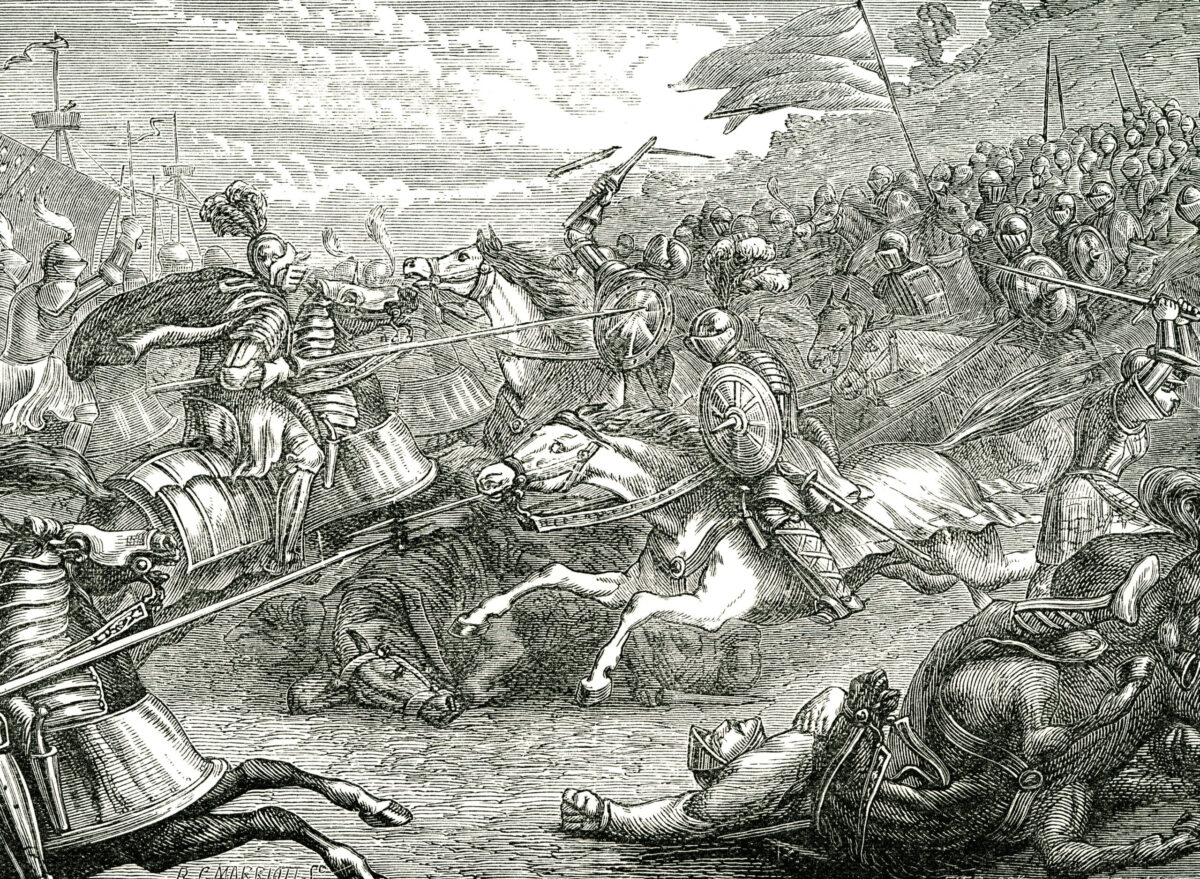King Henry VIII of England (reigned 1509-47) was obsessed with the survival of his dynasty, even demanding the marriage of his 6-year-old son, Edward, to the infant Mary Queen of Scots (born December 1542) in 1543. The Scots, however, turned Henry down flat. In his rage, he threw punitive attacks against the Scottish border in what became known as the “rough wooing.”
After Henry’s death, the lord protector of9-year-old King Edward VI, the Earl of Somerset, resumed the marriage demand with a major invasion of Scotland, sending 10,800infantry, 6,000 cavalry, 1,400 pioneers and 80cannon. Lord Grey of Wilton, as high marshal of the English army, commanded the cavalry, while Somerset and the Earl of Warwick, Lord Dacre of Gilles land, commanded the infantry. The English infantrymen were armed with longbows and billhooks (curved blades mounted on poles), but Somerset had the good sense to add more firepower in the form of several hundred German mercenary arquebusiers (infantrymen armed with shoulder-fired matchlock muskets) and a unit ofItalian mounted arquebusiers under Don Pedro de Gamboa. Sailing parallel to the army’s march north just off the coast were 30 heavily gunned English warships commanded by Lord Clinton.
In response to the invasion, Mary’s regent, the Earl of Arran, called up the levy of the kingdom, every Scottish male between the ages of 16 and 60. He assembled his 25,000 men in Edinburgh. The Earl of Home commanded 2,500 mostly inexperienced and untrained light cavalrymen, while Arran, the Earl of Angus and the Earl of Huntley each commanded one of the three Scottish infantry divisions, composed mostly of pikemen and some archers. While the Scots had plenty of artillery guns, these weapons were not as mobile as those of their English counterparts nor were the Scottish gun crews as well trained.
Arran positioned the Scottish army on high ground behind the River Esk with the sea on its left and a boggy marsh on the right at a place called Pinkie Cleugh (Scottish Gaelic for narrow glen or valley). The Scots built an earthen rampart to defend themselves against fire from the English ships’ guns, and Arran made his nearly immobile artillery guns more effective by putting them in a fixed position against which the English would have to attack.
When the English host arrived on September 9, Somerset was taken aback by the strength of the Scottish position. While he pondered how to attack the Scots, Arran made his first mistake – he allowed the Earl of Home to ride out with 1,500 of the untrained, inexperienced Scottish cavalrymen to challenge an equal number of English horsemen. It was a suicidal act, and the English knew how to take full advantage of the blunder. Lord Grey accepted the Scots’ challenge and promptly crushed the Earl of Home’s cavalrymen, eliminating Scottish cavalry for the rest of the battle.
As Somerset continued to worry about how his army could successfully assault the Scottish position, Arran became fearful that his army would become a stationary target for English artillery guns and longbowmen. The next morning, Arran made his second mistake. He rashly attacked, hoping his pikemen could quickly cross the intervening space between the two forces before English firepower could cut them down. Somerset could not believe his eyes as Arran solved his tactical problem for him.
As the Scots crossed the river, the ground narrowed, forcing the pike divisions to crowd together in a packed mass. Moreover, the left-hand division recoiled from the fire of the English ships’ guns, increasing the confusion and crowded disarray. Yet when Somerset threw his cavalry against the Scottish flank, the pikemen formed into a defensive “hedgehog” formation from which they impaled the attacking English cavalrymen. Lord Grey flung himself into the midst of this bloody shambles and was speared through the throat by a Scottish pike.
The repulsed English cavalry withdrew, but the English artillery gunners then blasted the Scottish pikemen, cutting bloody lanes through their packed ranks. The English longbowmen and arquebusiers soon added more deadly missiles to the ongoing slaughter. Gamboa led his mounted arquebusiers forward to fire at close range and then wheel their horses and race away in an effective new battle tactic being developed by armies on the Continent.
The stalled Scottish force had been reduced to merely a vulnerable target for fire from the English cannon, longbows, arquebuses and naval guns. Inevitably, panic swept through the Scottish army and the soldiers broke and fled, while Arran “took hastily to horse.” The English cavalrymen, determined to avenge their earlier losses, charged after the disorganized fugitives, resulting in a slaughter as the Scots rushed back to the bridge over the Esk or attempted to ford the river’s deep water or negotiate the swampy riverside bogs. The relentless pursuit went on for five miles, and perhaps as many as 6,000 Scots fell and 1,500 were taken prisoner. Somerset was so appalled by the butchery that he called off the chase.
Despite the decisive battlefield defeat, the Scottish government refused to give in to English demands for the royal marriage. Somerset’s army occupied a few Scottish castles, but then it withdrew back to England. Mary never married Edward.
In fact, Mary was spirited away to France to marry the dauphin, the heir apparent to the French throne. Although Mary was famously executed in 1567 by her cousin, England’s Queen Elizabeth I, in 1603 Mary’s son became James I, King of England and Ireland after the English and Scottish thrones were united that year.
Peter Tsouras is the author of 26 books on military history. He served in the Army and Army Reserve and worked for the Defense Intelligence Agency until retiring in 2010 to devote himself to writing, his roses and his grandchildren.





